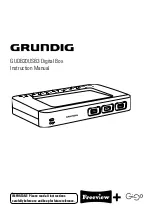
WiNRADiO G65DDC User’s Guide
12
The grounding requirement does not usually apply with antennas which
do not require ground as a counterpoise to the “live” terminal. For
example, the magnetic field loop antenna, which provides two output
terminals, and also some electric field antennas such as dipole, inverted
"V", etc. These antennas have balanced outputs, and will require
impedance matching to the Excalibur Ultra’s unbalanced 50 ohm input.
A "good" ground for a receiver is one that provides a low impedance path to
ground for radio signals in the frequency range of interest. A metal cold water
pipe located in close proximity to a possible ground connection point could
provide good results. If no such point exists, a copper stake hammered into
the ground may be required. Copper earth stakes can be obtained from
electrical supply outlets.
Assuming a typical installation where the coaxial cable to the receiver enters
the building at some point, an opportunity may exist to make a connection
between the outer shield of the coaxial cable and the suitable ground point. In
order for the grounding to be effective, the connection between the ground
point and the coaxial cable outer should preferably be no more than a few
meters in length. A low impedance connection (such as braid removed from a
section of coaxial cable) should be used to make the connection. In an ideal
situation, the length of coaxial cable to the receiver should be no more than a
few meters in order to provide a low RF ground impedance at the receiver.
In order to make a connection to the coaxial cable, a number of options exist.
These include WiNRADiO antenna accessories such as the
WR-CMC-30
Common Mode Choke
(see
www.winradio.com/cmc30
) or the
WR-LWA-0130
Long Wire Adapter
(sometimes referred to as a “
long wire
balun
”; see
www.winradio.com/lwa
) which, along with their other intended
purpose, the WR-CMC-30 provides a convenient ground connection stud that
will allow the connection to be made.
CAUTION: With any outdoor antennas, be sure to install a lightning
arrestor and disconnect the antenna (and ground it if possible) during
thunderstorms. To prevent receiver damage from static charge build-up,
always ground your antenna momentarily before connecting it to the
receiver.
If it is too difficult to make ground connections near the building, it may still be
well worthwhile experimenting at a point where connections can be more
made more easily. The
WR-CMC-30
Common Mode Choke
makes it
possible to provide several grounding points along the entire length of the
antenna feedline, in those locations where good quality grounding is available.













































